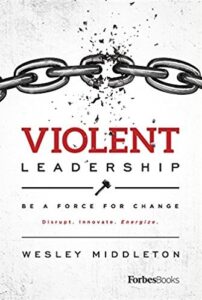Violent Leadership: Be a Force For Change
To achieve a goal, you need planning, action, risk and disruption. In Violent Leadership: Be a Force for Change, Wesley Middleton argues that leaders should be a force for change.
Wesley Middleton is the author of Violent Leadership: Be a Force for Change, co-founder and managing partner of Middleton Raines + Zapata LLP, a tax and accounting services firm.
I recently spoke to Wesley about his book.
Wesley, I’ve studied every type of leadership you can imagine. I’ve attended every seminar and read literally thousands of books. But this is a first. Violent leadership. Tell us more about this and why and how you started writing about it.
As I grew in my business, I learned that my ideas and thoughts weren’t “normal” for my profession. At the time, I didn’t recognize it. I believed that everything I was saying and doing was what everyone thought. It was when I started hearing “no” a lot and other professionals began questioning my ideas that I realized I was not thinking like everyone else. Because of that I began to write my experiences in short blog fashion and began to capture my thoughts and ideas on paper. After writing several articles and blogs, I realized I had a theme that was rooted in my faith. I lived by Matthew 11:12.
Matthew 11:12 (KJV) reads, “The kingdom of heaven suffereth violence and the violent take it by force.” The Modern English version says, “The kingdom of heaven is forcefully advanced, and the strong take it by force.” I was living by those incredible words: violence as force and as leadership.
Due to the obvious nature of the word violent, I kept it to myself. The phrase “Violent Leadership” is not something you would expect to see in the business world, yet it was what I lived by. The word refers to a distinctive type of leadership that is passionate, innovative, and disruptive and above all takes things by force. It does not refer to fighting, anger, or brutality. It is a positive and energetic pursuit of purpose and success. I decided to tell the world.
 Violent Leadership has been my style of leadership from day one. It has evolved and grown, been tempered and threatened with termination, but it is still at the core of my belief that goals and success do not just happen. Achievement takes planning, action, risk, and disruption—it takes Violent Leadership.
Violent Leadership has been my style of leadership from day one. It has evolved and grown, been tempered and threatened with termination, but it is still at the core of my belief that goals and success do not just happen. Achievement takes planning, action, risk, and disruption—it takes Violent Leadership.
Have a Willingness to Fail
Why is it important to have a willingness to fail?
Failure leads to success. Most stories of success are preceded by a string of failures. I find that most people are so scared to fail that they never step into the batter’s box. In baseball, the most successful batters fail seven out of ten times. Because they get up and go back to the plate and keep swinging—learning from their failures and changing their posture, approach or mechanics—they find success. The more at-bats you take, the more failure you will experience and the more you increase your odds of success. If we truly want innovation and change, the price we have to pay is failure. Allow ourselves and the people around us to fail. It is where we find success.
Create a Cool Culture
Creating an awesome culture is a passion of mine. You talk about creating a “cool culture.” I like that. What is it and how do we make it happen?
Culture is the most important element of our organization. The important thing to remember is that cool culture is intentional and starts at the top. We have defined our culture as five critical areas of development: people, passion, purpose, place and practices—the 5 P’s of a great culture. First define the culture you want to have. What are the words that describe it? By defining what we want our culture to look like, we create the culture we want. Next, it is important that the practices we employ on a day-to-day basis support how we have defined our culture. We have to live it. When this is applied to the 5 P’s, it is the beginning of a great culture that will need to be nurtured and protected.
What is generational disruption? What should leaders be aware of?
 Every generation is different. For whatever reason, the Millennial generation has brought significant attention to the differences in the generations. As I have researched, I have found that every generation has had significant differences. Leaders first have to recognize that there is a difference in the generations. There is a difference in the way each generation consumes goods and services, values work and family, and interacts with people. This generation is unique in that technology has played a critical role in the disruptive force. The way in which we market to each generation will be different: the sales presentation that we have will be different, and the manner in which the generation consumes the product or service will be different. I believe it would be a grave error to ignore the differences and not listen to this generation. Focusing on the perceived negative aspects won’t positively affect your organization—listening , learning and adapting will.
Every generation is different. For whatever reason, the Millennial generation has brought significant attention to the differences in the generations. As I have researched, I have found that every generation has had significant differences. Leaders first have to recognize that there is a difference in the generations. There is a difference in the way each generation consumes goods and services, values work and family, and interacts with people. This generation is unique in that technology has played a critical role in the disruptive force. The way in which we market to each generation will be different: the sales presentation that we have will be different, and the manner in which the generation consumes the product or service will be different. I believe it would be a grave error to ignore the differences and not listen to this generation. Focusing on the perceived negative aspects won’t positively affect your organization—listening , learning and adapting will.

